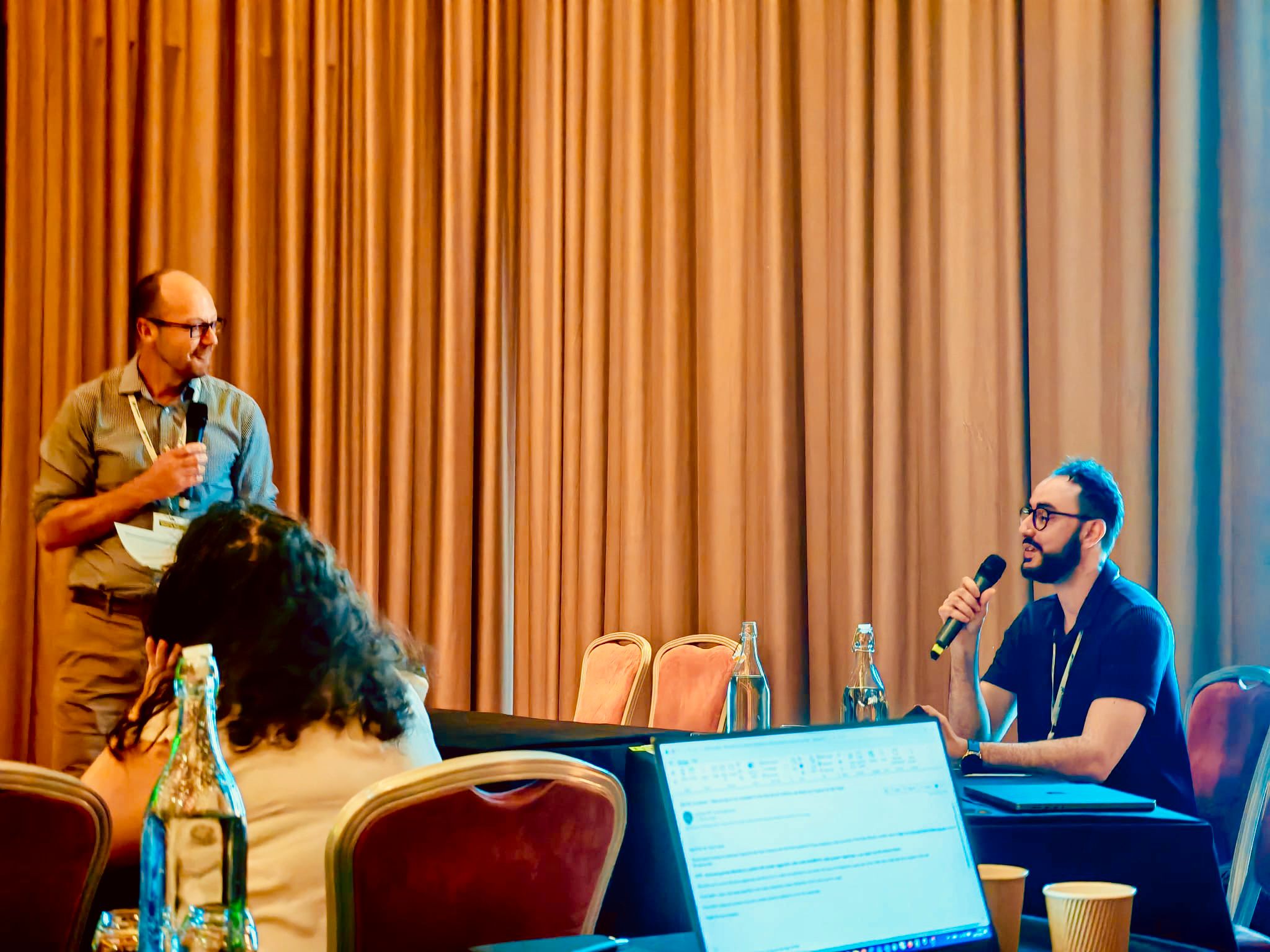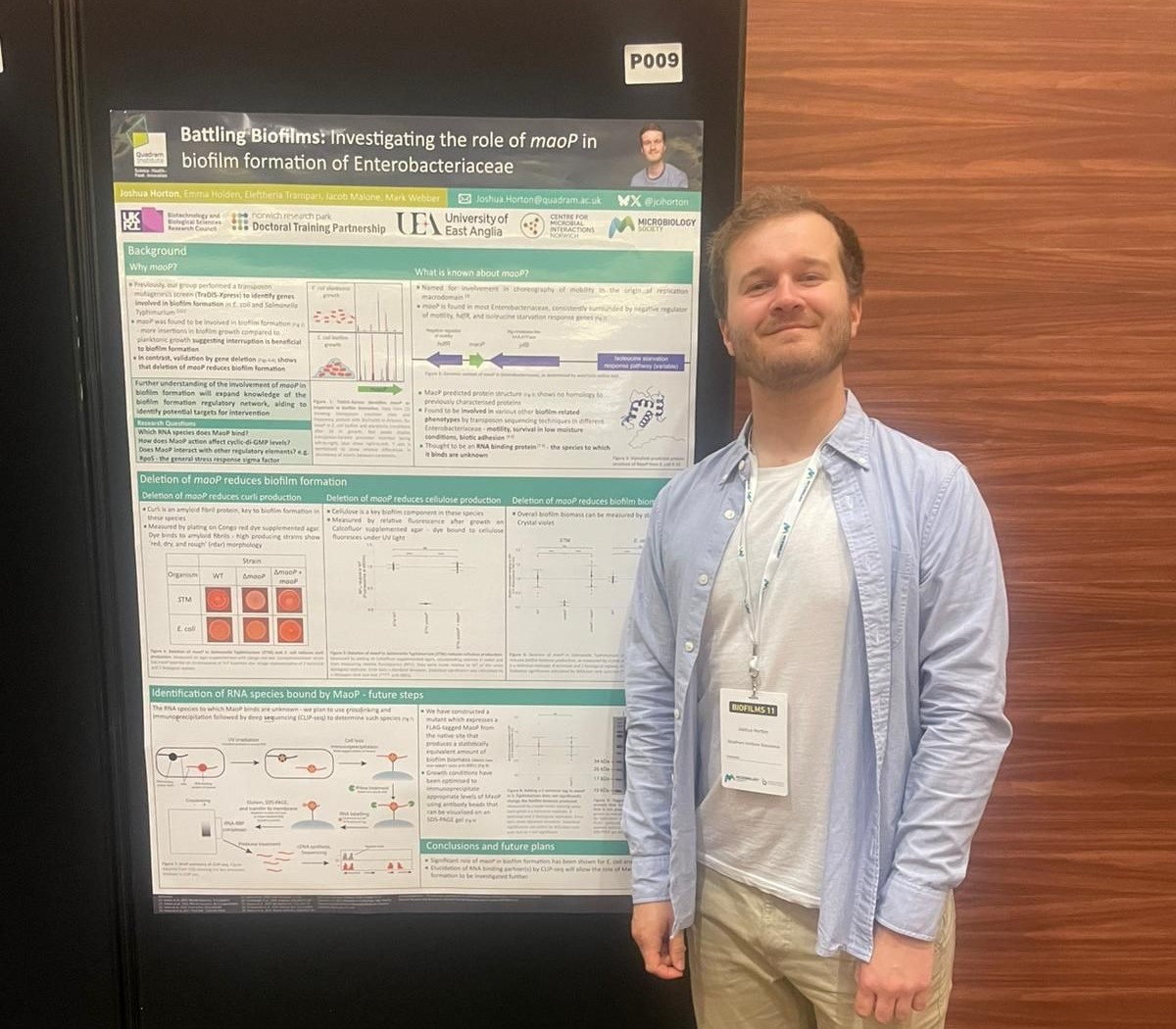Building connections in the biofilm community; reflections on the Biofilms 11 conference

Biofilms are communities of microbes that live and stick together on surfaces. They are found in a range of environments, from our teeth to our water. At the Quadram Institute, members of the Centre for Microbial Interactions study biofilms within the food chain and in the human gut, where they may have positive or negative impacts on our health.
A group of our members attended the Biofilms 11 Conference in Cardiff in May 2025. The conference showcased the broad scientific and societal opportunities and challenges of microbial biofilms and catalysing the exchange of ideas across boundaries.
Bringing microbiology research to an international scientific audience
Dr Bilal Djeghout highlights why he chose to attend the conference, “I attended Biofilm 11 in Cardiff to engage with the latest research on microbial biofilms, particularly in relation to food safety and pathogen persistence, areas closely tied to my work at the Quadram Institute.”
Four researchers from the Quadram Institute gave talks as part of the conference.
“I have been working on understanding the mechanisms of biofilm formation for the last seven years at the Quadram Institute. This was the first biofilm-specific conference I have attended,” explains Dr Emma Holden.
She continues, “I gave a flash presentation of my poster describing some work that I completed at the end of my PhD and followed up recently for a grant application. This poster described our work to characterise how a new gene affects biofilm formation in two gastrointestinal disease-causing microbes.”
Dr Eleftheria Trampari gave a talk on her research exploring how community composition and complexity drive Salmonella survival and adaptation under stress and a flash presentation on exploiting microbial interactions for safer food. Plus, Dr Ana Victoria Gutierrez spoke about her research into cellulose-driven adaptation in a persisting Listeria monocytogenes clone.
PhD student Ho Yu Liu adds, “I gave a three minute flash presentation and a poster presentation on factors that impact plasmid transfer in multispecies biofilms.”
Along with giving talks, our researchers presented posters about their findings too.
“Biofilms 11 was a great fit with my research interests, making it the perfect place to share key findings from my PhD. As I approach thesis submission, it came at just the right time. I presented a poster on my PhD work,” says PhD student Oleksii Omelchenko.
PhD student Joshua Horton adds, “My research covers biofilm formation in the foodborne pathogen Salmonella. Therefore this was the perfect conference for me to not only present my research but also learn from other researchers in my field.”

Learning about other areas of research
Along with being an opportunity to share ongoing research at the Quadram Institute, the Biofilms 11 conference offered a chance to learn from other researchers and to gain inspiration for future projects.
Oleksii reflects, “I wanted to get inspired by the latest research and learn about new techniques and ideas others are exploring in the field. I picked up some interesting new techniques for biofilm visualisation that I’m keen to try in my own work. I also learned about some exciting recent discoveries in the world of eDNA, which have given me new ideas for my research moving forward.”
As well as picking up new techniques, our members learnt how others approach similar problems in different ways.
Bilal explains, “Biofilms are a key factor in the survival of the disease-causing microbe Campylobacter jejuni in food processing environments. This conference offered a great opportunity to connect with researchers tackling similar challenges from different perspectives.”
The conference gave the opportunity to be exposed to totally new ideas too, as Josh points out.
“I really enjoyed a talk about the different types of extracellular DNA present in the biofilm extracellular matrix given by Professor Rikke Meyer from Aarhus University. Lots of new concepts were introduced during this talk that I did not know about previously. It was an exciting insight into the different research going on in the field,” he says.
Eleftheria reflects, “Highlights included new advances in biofilm research across diverse areas, from the food chain and clinical settings to marine applications. Notably, there is a growing focus within the community to explore more complex multispecies communities.”
Emma points out how the conference showed the diversity of biofilm environments covered, “There was a talk on controlling biofilm formation in the water management system at the international space station, which was so interesting to learn about!”
Developing new skills and careers
The Biofilms 11 conference gave the opportunity for scientists to develop their skills and careers.
Bilal says, “I had the honour of co-chairing a session on biofilm detection alongside Professor Jeremy Webb, co-director of the National Biofilms Innovation Centre. The session showcased cutting-edge technologies and experimental approaches for studying biofilm structure, viability, and resilience, many of which could inform the microscopy and in vitro modelling work I’m doing at the Quadram Institute.”

Emma points out the impact on her career, “I am in the process of drafting a grant or fellowship proposal to begin the next stage of my career as an independent researcher. The conference allowed me to see the current work being undertaken on biofilm formation in the field.”
Ho Yu echoes this, “As this conference was a focused meeting, I really enjoyed being able to have in depth conversations with lots of researchers at different stages of their careers.”
Connecting with colleagues and tackling global challenges together
“Beyond the exciting science, one of the biggest highlights for me was the chance to spend time with colleagues, something we don’t always get to do in the day-to-day routine,” says Oleksii.
He continues, “It was a great way to connect on a more personal level, learn more about the people we work with, and discover where our research interests might overlap.”
As part of the conference there were opportunities to network with people from other organisations too. Josh explains, “The drinks reception at the end of the conference, at the National Museum Cardiff, was a great close to the conference. It gave us a chance to network with researchers in a more informal setting.”
Emma adds, “I spoke to a research group using pig lungs as a model biofilm system with a view to hopefully collaborate with them in future work.”
Forging these new connections and collaborations allows researchers to tackle global challenges together.
Bilal reflects, “The Biofilms 11 conference highlighted how collaboration across sectors is key to tackling biofilm-related issues in public health and industry. Being part of Biofilm 11 reminded me how vibrant and interdisciplinary the biofilm research community is.”
He concludes, “It was energising to see how our work at the Quadram Institute fits into a much broader effort to solve persistent microbial challenges, and to contribute to that dialogue was genuinely rewarding.”